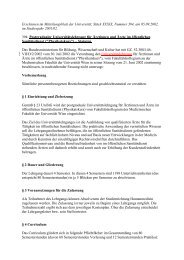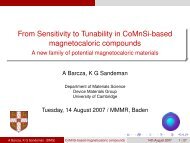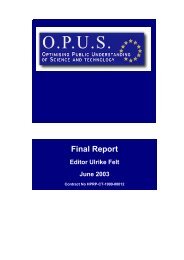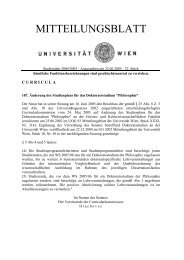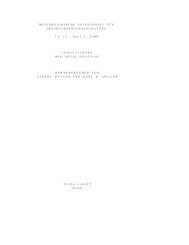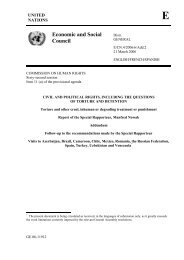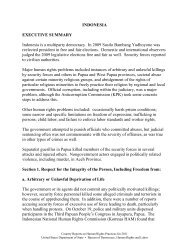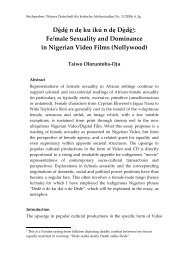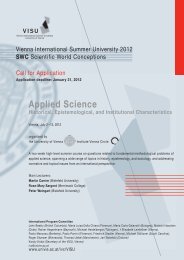(Stand: 25. Juli 2007) ANDERSON, Michael Alan ... - Universität Wien
(Stand: 25. Juli 2007) ANDERSON, Michael Alan ... - Universität Wien
(Stand: 25. Juli 2007) ANDERSON, Michael Alan ... - Universität Wien
Create successful ePaper yourself
Turn your PDF publications into a flip-book with our unique Google optimized e-Paper software.
MEDIEVAL & RENAISSANCE MUSIC CONFERENCE <strong>2007</strong> – WIEN, 7.-11. AUGUST ABSTRACTS<br />
VAN BERCHUM, Marnix (Utrecht University)<br />
Fortune, mercy & death – two masses of Jachet Berchem<br />
Freitag/Friday, 10.8., 16.30 Uhr, MuWi, HS 1<br />
In total four masses have in one or more sources an attribution to Jachet Berchem. Two of<br />
these masses are also attributed to Jachet of Mantua, with three books of masses and three<br />
books of motets the more ‘sacred’ composer of the two Doppelmeister. The other two<br />
masses have an unproblematic attribution to Berchem: the Missa Mort et fortune (a4) and<br />
the Missa Mort et merci (a5). Both masses were first published by the printers Gardano and<br />
Scotto in the 1540s (the decade in which Berchem probably resided a few years in Venice)<br />
and have other prints and several later manuscripts as concordant sources. The two<br />
masses use the chansons Mort et fortune of Nicolas Gombert (first printed in 1538 by Moderne)<br />
and Mort ou merci of Adrian Willaert (first printed in 1560 by Le Roy & Ballard) as<br />
their models. Remarkable is that the models used by Berchem both start with the word<br />
‘mort’.<br />
In this paper I will focus on these two masses, their sources and the way Berchem<br />
treats the models. I hope to shed some light on possible extramusical relations between the<br />
two masses and the two chansons on which they are based.<br />
� �<br />
VAN DAMME, Simon (Katholieke Universiteit Leuven)<br />
Quasi una taciturnità – The theoretical silence and practical salience of dissonance<br />
Samstag/Saturday, 11.8., 11.15 Uhr, KuGe, SR 3<br />
In his letters, the Italian theorist and composer Giovanni Spataro defends his own compositions<br />
against contrapuntal errors, pointed out by his colleague Pietro Aaron. Several<br />
times, he argues that certain dissonances are allowed because they are simply not perceived<br />
by the ear. This is the case when a dissonant interval occurs not on the beginning<br />
of a note but only in the middle of it (as with figurations over a sustained note or as with<br />
syncopation). He refers explicitly to the writings of Gaffurius who stated that there are<br />
some kind of „taciturnitates“ between the „percussiones“ of the notes to distinguish them<br />
from the other notes (De harmonia instrumentorum opus, 1518, I-2). Even if some applications<br />
of this theory show clear contrapuntal shortcomings, Spataro uses it as an argument in his<br />
letters, underpinning his practical work with the authority of speculative theory.<br />
Interestingly enough the concept of „silence between the notes“ appears in at least<br />
two major sixteenth-century treatises. Glareanus mentions briefly that the dissonant interval<br />
of a whole tone is not heard in a syncopated formula (as in a regular cadence, Dodecachordon,<br />
1547, I-9). More extensively, Zarlino explains that the only dissonances allowed<br />
on the first beat of the measure are suspensions, using the same words „taciturnità“ and<br />
„percussione“ but without crediting Gaffurius (Le istitutioni harmoniche, 1558, III-42).<br />
This idea of silence contrasts with the legato style, heard in performances of Renaissance<br />
music nowadays. Starting from this remarkable contradiction between the theoretical<br />
subtleties and the actual aural image of the polyphonic texture, this paper will consider<br />
how aspects of sound quality and the idea of melodic movement are treated in Renaissance<br />
music theory and how this relates to the authority of the musician’s ear.<br />
- 75 -




